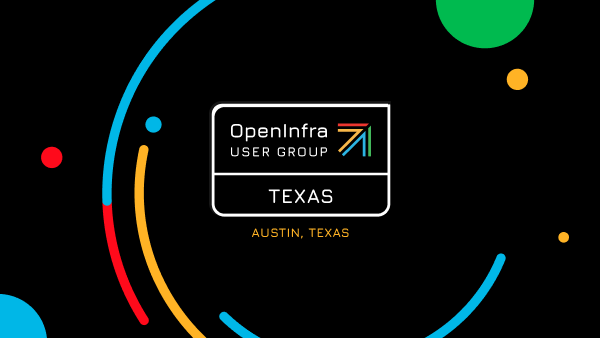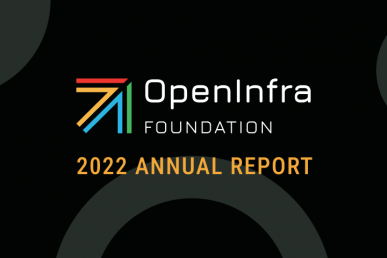At the OpenInfra Foundation, we foster communities of developers, operators, and users around open source projects like OpenStack. One of the ways we do this is by hosting an annual OpenInfra Summit (in fact we have one coming up in June 2023 in Vancouver!). However, in the time between Summits, we continue to facilitate community growth by supporting our local communities via user groups and OpenInfra Days.
These types of events are crucial to the success of our communities as they provide opportunities for community members who are not able to join us for the annual Summit to continue to engage with the community.
To begin, my experience reorganizing the Austin OpenInfra Group may be a bit different from yours as I work for the OpenInfra Foundation and I had access to the Foundation’s resources directly. What you may not know is that the resources I mention in my experience below are also accessible to you! Contact us at [email protected] and we can help you out.
Before we get started, here are a few suggestions:
- Make sure you are subscribed to the community mailing list to get updates on user groups and OpenInfra Days.
- Join the OpenStack LinkedIn group.
- Contact [email protected] to make sure you have the most updated resources.
During the pandemic, like many other groups, the Austin user group became rather inactive. And being located in the area, I wanted to reorganize it. I got in touch with the former organizer and discovered they had moved on from the previous position that allowed them to organize the group. From there I worked to move the group’s organizer positions around so that the OpenInfra Foundation was the organizer and I was the co-organizer.
Step 1: Finding a Host
After setting up the group Meetup page with some fresh graphics our design team created, I immediately wanted to get started on planning the first meetup.
The first issue I came across was where to host the meetup. Before setting a date I wanted to secure a venue. I approached this by posting to the Meetup group’s discussion board.
I posted it and left it up for about a week. Unfortunately, no replies came in. I am thinking people do not get notified of a post to the discussion board unless they visit the page, and since the group has been inactive for a few years, I figured no one was really checking it out. So on to Plan B.
Step 1: Plan B
I used the “contact members” option to send an email out via the meetup page’s mailing list. I sent the following message:
Hi Everyone!
I have recently taken on one of the co-organizer positions for the Austin OpenStack Meetup group. I am hoping to get the group together soon. Right now, I am trying to find some space to gather. Does anyone perhaps have a conference room they can donate for the meetup? If so, contact me at [email protected].
I look forward to seeing everyone soon!
Cheers,
Helena Spease
A community member in the Austin, TX area responded to my email and offered a conference room for 15 attendees! After going through an approval process with their office manager, we had a venue.
Seeing as the venue space was limited, I decided to add a live stream option via zoom for others to join. Also, I planned a post-meetup social hour at a pizza place down the street from the venue so that online participants could join us.
If this process is not successful for you a few other ideas I had in mind to find a venue host included:
- Reviewing the member’s list on openinfra.dev/members to find companies from the list located in your area and reach out to them. (the OpenInfra Foundation has contacts for all these members, which we can put you in touch with if you let us know).
- Contact nearby universities for space.
- Reach out to other tech companies located in your area.
- Check public spaces the city can offer (i.e. booking a conference room in the local library).
Step 2: Speakers
After securing a venue I needed to figure out some speakers. First I checked with colleagues. I was able to confirm one colleague as a speaker and gained two more recommendations from other organizations my colleagues had contacts with.
A few other techniques I found successful for confirming speakers:
- Reviewing the schedule from past OpenInfra Summits for speakers.
- Reviewing the full list of user groups supported by the foundation and contacting other organizers for speaker recommendations.
- Sending a call for speakers out on the community mailing list.
- Searching who is located in the area via the OpenStack LinkedIn group.
- Reviewing the list of OpenInfra Foundation member organizations.
If you need assistance with finding venue space or speakers, do not hesitate to reach out to [email protected] for assistance.
Step 3: Snacks/Drinks
Since we are a small group and are planning to go to a pizza place following the meetup, I decided that I would not seek out a drinks/snacks sponsor. I figured it would be easiest to grab a case of drinks and some light snacks myself.
Step 3: Promoting the Meetup
I used Meetup’s contact feature to announce the event to the group members when I initially posted the meetup, to share details on the confirmed speakers, as well as share the Zoom information.
I took to my personal social media channels to promote the event. As well as taking advantage of the OpenInfra Foundation’s official social media channels to promote the meetup. If you would like to promote your meetups via the OpenInfra channels, please reach out to [email protected].
Step 4: The Hybrid Setup
This was by far the most difficult aspect of the meetup. Prior to the meetup, I set up a paid Zoom account so that I was not limited to the free version’s 40-minute limit, as well as a YouTube account to live stream to.
One thing to note when setting up a YouTube account is that YouTube has multiple checks in place to prevent spam accounts. So your account is put on a 24-hour hold before you can live stream as well as will require proof of ID. You can find the information for those steps at youtube.com/features.
I tested Zoom along with the YouTube live connection ahead of time. However, the difficulty came when setting up technology in conjunction with the technology the office space provided. Unfortunately, my camera setup did not work very well, nor did I remember to click the live stream button. So, in the end, I ended up saving the recording from the Zoom meeting, and editing it over the slides, without footage of the speakers.
In the future, I think the setup that would work best is to share my slides via Zoom, have Zoom projected on the screen, and zoom configured in the single speaker presentation view with the footage of the speaker footage pinned. This setup made the most sense for the recording and reposting of the presentations.
As you set up your YouTube channels or any other social media platforms you choose to use to promote your meetups, please share them with us so we can help to promote them.
Step 5: The Social hour
The post-meetup pizza hour was an engaging and beneficial part of the meetup. This segment of the meetup allowed our speakers to elaborate on points, allowed those who were not able to come in person for the core part of the meetup to engage with the group, and to overall make the meetups an enjoyable experience.
A few more points
Of course, there were a few hiccups, however all-in-all it was an amazing experience. It was incredibly rewarding to get together with a group of people passionate about the OpenInfra community.
One of the things I found very beneficial was at the end of the meetup I asked for feedback. This helped me get an idea of what I should change for future meetups as well as get an idea of who would be interested in hosting, speaking, bringing snacks, and so on.
I would love to hear your suggestions/experiences hosting meetups or if you have any questions please feel free to reach out to [email protected].
- Inside Open Infrastructure: April 2024 - April 3, 2024
- Inside Open Infrastructure: January 2024 - January 18, 2024
- Inside Open Infrastructure: October 2023 PTG Recap - November 15, 2023

)










